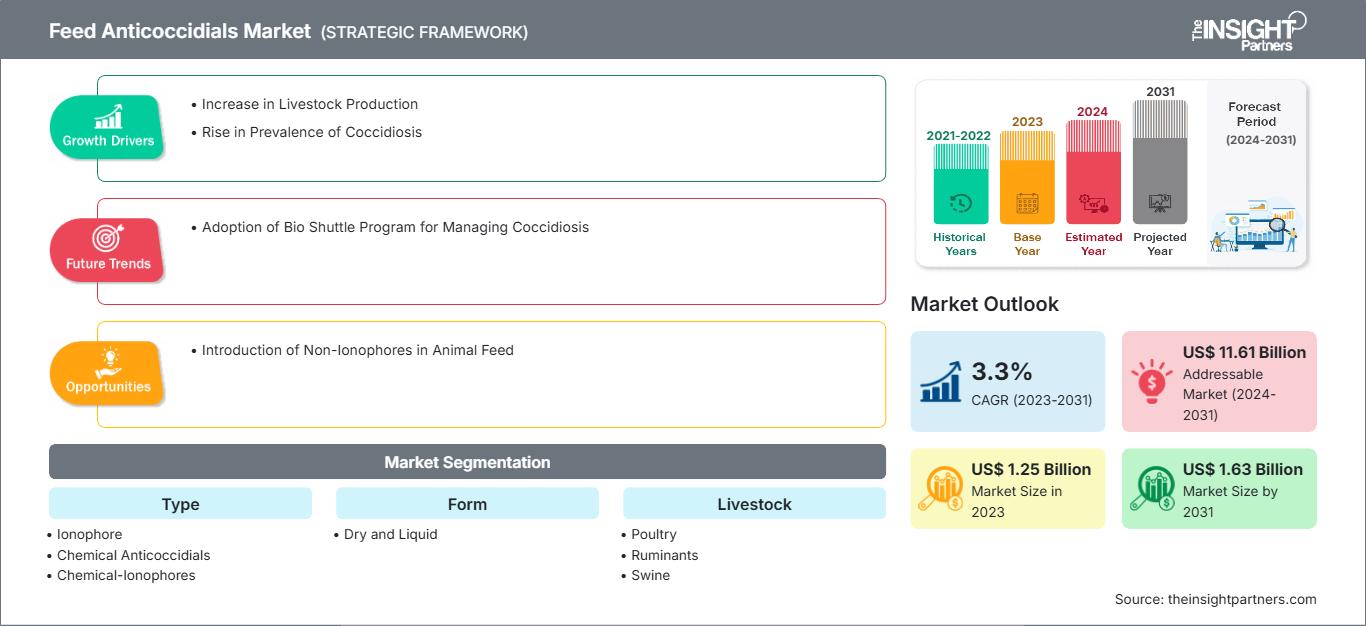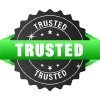The feed anticoccidials market size is projected to reach US$ 1.63 billion by 2031 from US$ 1.25 billion in 2023. The market is expected to register a CAGR of 3.3% during 2023–2031. The rising adoption of bio shuttle programs is likely to continue as a key trend in the market. The bio shuttle program involves strategically using advanced technologies and practices to prevent coccidiosis and enhance bird health and performance. The program can improve feed conversions and weight gain while assisting in managing intestinal injuries.
Feed Anticoccidials Market Analysis
The growth in livestock production is likely to create a demand for feed anticoccidials to fight against diseases such as coccidiosis. Livestock farmers are also concerned about the health of livestock. Thus, they are adopting various strategies to fight against diseases and investing in feed antibiotics such as anticoccidials. Phibro Animal Health Corp, Kemin Industries Inc., Elanco Animal Health Inc., Zoetis Inc., and Huvepharma EOOD are among the major feed anticoccidials manufacturers operating in the market. Market players are investing in research & development to launch more efficient products with improved benefits to attract a large number of consumers.
Feed Anticoccidials Market Overview
Feed anticoccidials are feed additives used to prevent intestinal diseases such as coccidiosis among livestock animals. It is considered an antibiotic in animal feed. There are three types of feed anticoccidials available i.e., ionophores, chemical anticoccidials, and chemical-ionophores. The prevalence of coccidiosis is increasing in poultry birds, equines, and ruminants. Thus, livestock farmers and feed manufacturers are incorporating anticoccidials in animal feed that can further reduce the impact of intentional disease caused by parasites. Moreover, the surging livestock population across the globe with increasing meat and dairy consumption creates a huge demand for feed anticoccidials as a feed additive.
Customize This Report To Suit Your Requirement
You will get customization on any report - free of charge - including parts of this report, or country-level analysis, Excel Data pack, as well as avail great offers and discounts for start-ups & universities
Feed Anticoccidials Market: Strategic Insights

-
Get Top Key Market Trends of this report.This FREE sample will include data analysis, ranging from market trends to estimates and forecasts.
Feed Anticoccidials Market Drivers and Opportunities
Rise in Prevalence of Coccidiosis
Coccidiosis directly infects animals and reduces their performance; it results in large economic losses. Owing to its direct impact on flock appearance and intestinal health, it is a major global concern in the poultry industry. The EW Nutrition Technical Team reports that coccidial illness costs the poultry sector more than US$ 14 billion a year and is a serious intestinal problem. Owing to damage to the intestinal cells, the disease results in decreased body weights, increased feed conversion rates, abnormalities in skin color, irregular flock sizes, and ultimately, death. According to DSM, across the world, yearly losses were estimated at more than US$ 3 billion due to coccidiosis in chickens and other avian species. Thus, coccidiosis prevention is becoming essential for producers, veterinary associations, and regulatory authorities of various countries.
According to the World Health Organization (WHO), the usage of antibiotics such as an anticoccidial in animal feed as an additive can treat infections. There is a surge in the use of anticoccidials in feed by animal feed manufacturers to fight against infection in animals, overcome losses, and improve farm profitability. Thus, the rising prevalence of coccidiosis fuels the feed anticoccidial market growth.
Introduction of Non-Ionophores in Animal Feed
Non-ionophores are compounds produced by chemical synthesis; thus, they fall under the category of chemical anticoccidials. They destroy coccidia by cidal activity or suppress coccidia by static activity. They have no known antibacterial activity; hence, they are not considered as an antibiotic. Non-ionophores are products containing nicarbazin, zoalene, amprolium, clopidol, decoquinate, robenidine and diclazuril. EW Nutrition—an agribusiness company that creates solutions that bring reliable benefits with reduced need for antibiotics, especially in feed—has developed non-ionophores for animal feed. Owing to all these factors, livestock farmers concerned about using antibiotics in animal feed can opt for non-ionophore anticoccidials. Therefore, the introduction of non-ionophore in animal feed is expected to offer lucrative opportunities for the feed anticoccidials market during the forecast period.
Feed Anticoccidials Market Report Segmentation Analysis
Key segments that contributed to the derivation of the feed anticoccidials market analysis are type, form, and livestock.
- Based on type, the feed anticoccidials market is segmented into ionophores, chemical anticoccidials, and chemical ionophores. The ionophore segment held the largest market share in 2023.
- By form, the market is bifurcated into dry and liquid. The dry segment held a larger share of the market in 2023.
- In terms of livestock, the market is segmented into poultry, ruminant, swine, and others. The poultry segment held a significant share of the market in 2023.
Feed Anticoccidials Market Share Analysis by Geography
The geographic scope of the feed anticoccidials market report is mainly divided into five regions—North America, Asia Pacific, Europe, the Middle East & Africa, and South & Central America. Asia Pacific held the largest market share in 2023, whereas the market in South & Central America is expected to register the highest CAGR during the forecast period.
The feed anticoccidials market in South & Central America is driven by the growing livestock industry and rising producer awareness about animal health. Brazil, Argentina, and Mexico are among the major players in the global meat export market, majorly in the beef and poultry sectors. The growing livestock sector increases the use of effective disease management solutions, including anticoccidials, to protect animal health and boost productivity. Anticoccidial drugs are crucial in controlling coccidiosis, a major concern for poultry and other livestock, which can significantly impact farm profitability by reducing productivity. The adoption of these practices is gaining momentum in health and nutrition management, aiming to prevent coccidiosis, enhance animal health, and improve feed efficiency. Hence, the region has experienced a significant increase in the use of anticoccidial feed additives.
South & Central America is experiencing a growing trend toward sustainable and environmentally friendly livestock production practices. Moreover, the region's regulatory frameworks are changing to ensure food safety and animal welfare. The demand for anticoccidial solutions is driven by the growing consumption of animal protein and rising global market exports. This factor, along with enhanced livestock health standards and productivity, would present significant opportunities for the feed anticoccidials market in the region during the forecast period.
Feed Anticoccidials Market Regional Insights
The regional trends and factors influencing the Feed Anticoccidials Market throughout the forecast period have been thoroughly explained by the analysts at The Insight Partners. This section also discusses Feed Anticoccidials Market segments and geography across North America, Europe, Asia Pacific, Middle East and Africa, and South and Central America.
Feed Anticoccidials Market Report Scope
| Report Attribute | Details |
|---|---|
| Market size in 2023 | US$ 1.25 Billion |
| Market Size by 2031 | US$ 1.63 Billion |
| Global CAGR (2023 - 2031) | 3.3% |
| Historical Data | 2021-2022 |
| Forecast period | 2024-2031 |
| Segments Covered |
By Type
|
| Regions and Countries Covered |
North America
|
| Market leaders and key company profiles |
|
Feed Anticoccidials Market Players Density: Understanding Its Impact on Business Dynamics
The Feed Anticoccidials Market is growing rapidly, driven by increasing end-user demand due to factors such as evolving consumer preferences, technological advancements, and greater awareness of the product's benefits. As demand rises, businesses are expanding their offerings, innovating to meet consumer needs, and capitalizing on emerging trends, which further fuels market growth.

- Get the Feed Anticoccidials Market top key players overview
Feed Anticoccidials Market News and Recent Developments
The feed anticoccidials market is evaluated by gathering qualitative and quantitative data post primary and secondary research, which includes important corporate publications, association data, and databases. A few key recent developments in the feed anticoccidials market are listed below:
- Zoetis and Phibro Animal Health acquired Zoetis' medicated feed additive product portfolio, water-soluble products, and related assets for US$ 350 million. The acquisition, which generated US$ 400 million in revenue in 2023, includes over 37 product lines and six manufacturing sites. (Source: Phibro Animal Health, Company Website, April 2024)
- Elanco Animal Health Inc introduced ZoaShield in the US, a flexible zoalene solution designed to control coccidiosis in poultry, particularly in No Antibiotics Ever flocks, for various seasons and operations. (Source: Elanco Animal Health Inc, Press Release, May 2021)
- Baur & Co Ltd joined Elanco Animal Health in launching two new veterinary products in Sri Lanka, introducing two new products to the livestock sector. (Baur & Co Ltd, Press Release, March 2021)
Feed Anticoccidials Market Report Coverage and Deliverables
The "Feed Anticoccidials Market Size and Forecast (2021–2031)" report provides a detailed analysis of the market covering below areas:
- The feed anticoccidials market size and forecast at global, regional, and country levels for all the key market segments covered under the scope
- The feed anticoccidials market trends as well as market dynamics such as drivers, restraints, and key opportunities
- Detailed Porter's Five Forces and SWOT analysis
- The feed anticoccidials market analysis covering key market trends, global and regional framework, major players, regulations, and recent market developments
- Industry landscape and competition analysis covering market concentration, heat map analysis, prominent players, and recent developments for the feed anticoccidials market
- Detailed company profiles
Frequently Asked Questions
What are the future trends of the feed anticoccidials market?
Which region dominated the feed anticoccidials market in 2023?
What are the driving factors impacting the feed anticoccidials market?
What would be the estimated value of the feed anticoccidials market by 2031?
Which are the leading players operating in the feed anticoccidials market?
- Historical Analysis (2 Years), Base Year, Forecast (7 Years) with CAGR
- PEST and SWOT Analysis
- Market Size Value / Volume - Global, Regional, Country
- Industry and Competitive Landscape
- Excel Dataset
Recent Reports
Related Reports
Testimonials
Reason to Buy
- Informed Decision-Making
- Understanding Market Dynamics
- Competitive Analysis
- Identifying Emerging Markets
- Customer Insights
- Market Forecasts
- Risk Mitigation
- Boosting Operational Efficiency
- Strategic Planning
- Investment Justification
- Tracking Industry Innovations
- Aligning with Regulatory Trends





















 Get Free Sample For
Get Free Sample For